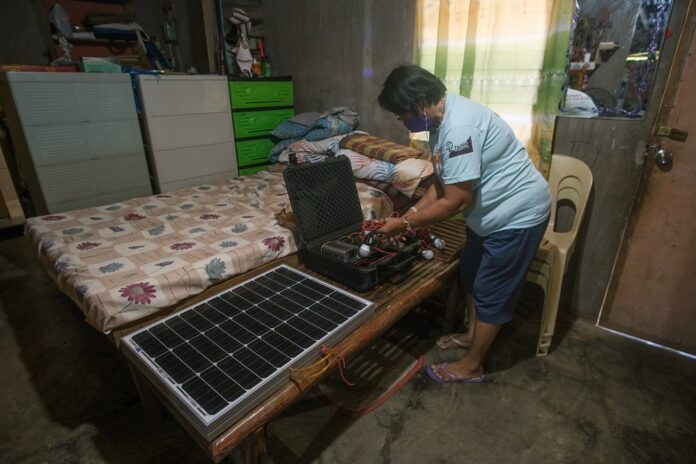Lorna dela Pena takes out her TekPak solar-powered generator at her home in Marabut, Philippines October 17, 2021. — Picture by Thomson Reuters Foundation/Geela Garcia
MARABUT, Philippines, Dec 14 — When Haiyan, one of the most powerful tropical cyclones ever recorded, smashed into the central Philippines in 2013, the town of Marabut in Eastern Visayas region suffered zero casualties.
More than 1,000 residents scrambled up 32 feet (9.75 m) of slippery soil and limestone to take refuge inside the Tinabanan Cave, known for providing shelter since colonial times.
Lorna dela Pena, 66, was alone when the super-typhoon landed on November 8, killing more than 6,000 people nationwide and forcing about 4 million from their homes.
She remembered how everything was “washed out” by the storm, but despite being “lost in a daze”, she managed to evacuate.
“There still weren’t stairs to comfortably climb up to the cave. My grandfather’s dream was for it to have stairs,” she said, noting they were finally put in after the Haiyan disaster.
While serving hot porridge to evacuees, dela Pena grasped how important local organisations are to helping communities become more resilient to fiercer weather, as the planet warms.
“It’s stronger when more people unite to help. What one can’t do is possible when everyone unites,” she told the Thomson Reuters Foundation.
Following that experience, she worked with others in Marabut to build up women’s groups focused on different issues.
Now they take the lead in organising workshops on organic farming, hold discussions on violence against women, and educate and encourage other women to adopt renewable energy.
Azucena Bagunas, 47, and dela Pena are among “solar scholars” trained by the Philippines-based Institute for Climate and Sustainable Cities (ICSC), an international nonprofit that promotes low-carbon development and climate resilience.
In an effort to prepare better for disasters after Typhoon Haiyan, known locally as Yolanda, the women learned to operate portable solar-powered generators called TekPaks, which they use during evacuations.
Life-saving technology
The TekPaks light up the dark Tinabanan cave, making it easier to count the number of people seeking shelter there, and charge mobile devices to keep communication lines open.
For Bagunas, the most memorable use of the technology was when it helped save a life.
“We were able to use this TekPak to power a nebuliser when someone had an asthma attack,” she recalled.
Bagunas and dela Pena share their knowledge by teaching other women to operate TekPaks and making them aware of the benefits of renewable energy.
Now, whenever a storm is coming, women in Marabut ensure their solar-powered equipment is charged so they are ready to move their communities to safety.
Bagunas said harnessing solar energy was also cheaper than relying on coal-fired electricity from the grid.
“If we use (solar) as our main source of power in our homes, then we don’t even have to pay for electricity,” she said. “As long as you have a panel, you’ll have affordable and reliable power.”
Bagunas also prefers solar as a safer option.
In June, her brother’s house next-door went up in flames when a live electricity wire hit his roof, with the fire reaching some parts of her own house.
Women’s work
According to 2020 data from the Department of Energy, about 60 per cent of the Philippines’ energy still comes from coal and oil, with only about 34 per cent from renewable sources.
But under a 2020-2040 plan, the government aims to shift the country onto a larger share of renewable energy such as solar, rising to half of power generation by the end of that period.
Chuck Baclagon, Asia regional campaigner for 350.org, an international group that backs grassroots climate action, said the ICSC’s efforts to bring solar power to communities would help expand clean energy at the local level.
Today’s model of a centralised power system reliant on fossil fuels does little to address energy poverty in remote island areas far from commercial centres, he added.
“The shift to solar energy dispels the myth that we can’t afford to transition,” he said. “The reason why fossil fuel is expensive is that it’s imported so it’s volatile in the market.”
Renewable energy sources like solar, however, are easier to build locally because they harness what is available and has the highest potential in particular locations, he added.
Leah Payud, resilience portfolio manager at Oxfam Philippines, said her aid agency supported initiatives to introduce solar energy in poor rural communities, especially because it helps women and children who are among the most vulnerable to climate change.
“During disasters, the unpaid care work and domestic work of women doubles,” she said, adding their burden is made heavier by having to find an energy source to carry out those jobs.
“Women don’t have access to a clean kitchen to cook their meals, and there is no electricity to lighten their tasks, for example when breastfeeding or sanitising equipment,” she said.
The direct benefits women can gain from clean, cheap and easily available energy mean they should be involved in expanding its adoption, she added.
“They are the mainstream users and energy producers — and without their involvement, renewable energy initiatives can become inappropriate,” she added. “There is no climate justice without gender justice.”
One good way to introduce women to renewable energy is by asking them to draw a 24-hour clock of their chores at home and identifying the energy they use to do them, Payud said.
They then consult with Oxfam staff on how switching energy sources could lighten their responsibilities, making it “very relatable”, she added.
The exercise has revealed that many women spend at least 13 hours a day doing unpaid family care work, a load that has increased during the Covid-19 pandemic due to home-schooling.
Quick and safe
On Suluan Island, a three to four-hour boat ride from the mainland, women are tasked with collecting water in energy-deprived areas, putting them at risk when they have to go out after dark.
They have found solar lights more reliable than oil lamps because they do not have to cross the sea to buy fuel for them.
Payud said solar was the best energy source during a disaster, especially when the mains power supply is cut and it is impossible to travel between islands.
After Haiyan, it took half a year to restore grid power in far-flung communities, but that would not have been the case had women had access to alternative energy such as solar, she said.
For dela Pena and Bagunas, women should be at the forefront of tackling climate change and energy poverty because they act as “shock absorbers”.
“Women oversee the whole family, and whenever there are problems, they are the ones who try to address it first,” said Bagunas. — Thomson Reuters Foundation


